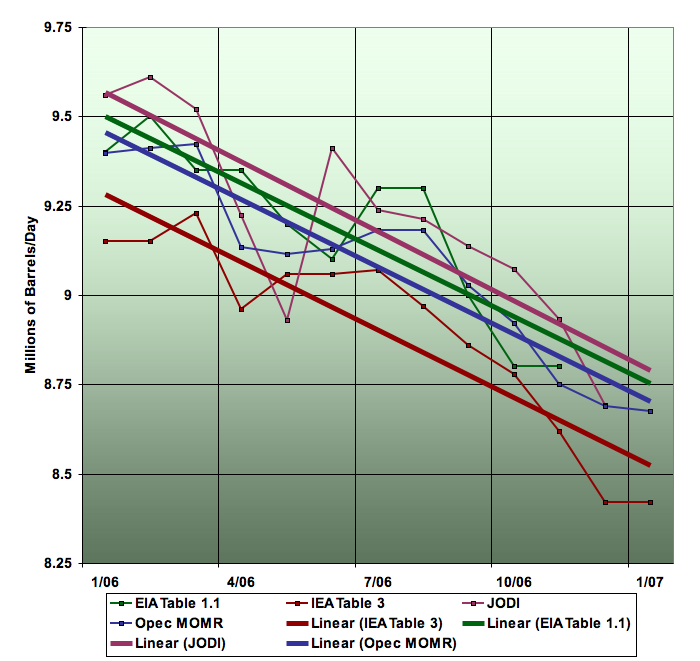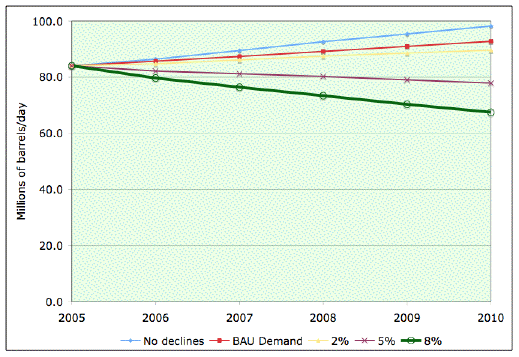The idea that nitrogen fertilizer production is dependent on oil and gas is a myth -- a really stubborn and persistent myth. In fact, just this morning I woke up to find yet another uninformed bozo spreading the big lie:
If we are unprepared for Peak Oil the potential outcome may be devastating for our way of life and that of the world. Unfortunately Peak Oil is expected to coincide with Peak Food because oil is required for food growth and delivery.Source
We can debate the part about delivery, but the part where it says "oil is required for food growth" is nothing but pure, straight-from-the-rump bullshit.
I have previously addressed this issue in a number of posts:
28. ISN'T FERTILIZER MADE FROM CRUDE OIL?,
174. ARE HIGH FERTILIZER PRICES A THREAT TO THE FOOD SUPPLY?, and
176. THE OIL-BASED FERTILIZER MEME. But this myth really dies hard. So allow me to explain again, and hopefully enlighten a few more people to the actual facts.
I'd also like to enlist the help of the rational wing of the peak oil movement. Can we redouble our efforts to challenge this myth, and ensure that the general public has access to the truth instead of endless repetition of the same lie?
The key facts are very simple:
1) You don't need oil, natural gas, coal or any other fossil fuel to make nitrogen fertilizer.
2) All you need to make nitrogen fertilizer is air, water and energy.back40, a soil scientist from the blog Muck and Mystery, has a great
post describing the situation*:
Natural gas, methane, is a common feedstock for nitrogen fertilizer production since it has four nice hydrogen atoms, which is what is of use for fertilizer, and it is used as an energy source for heat and pressure production to enable the catalyzed reactions to take place.
But that's just one way to make ammonia, the simplest type of nitrogen fertilizer. At the turn of the century ammonia was a waste byproduct of coke production from coal that was sold as an industrial chemical and later as fertilizer. This is still so. But coal is still a fossil fuel albeit a much more abundant one. This debunks the peak oil whingers but not the anti-fossil whingers.
The earlier post Fire Down Below noted Iceland's use of geothermal energy and efforts to greatly increase production. One of their proposed uses of all that energy is to make hydrogen from water and export it around the world. They could use that hydrogen to make ammonia fertilizer and export that instead. It might be easier and more profitable.
Any energy system could be used to make hydrogen. We've heard of wind farms planning to use their peak output energies to make hydrogen as a way of storing the energy from intermittent winds. The hydrogen is a sort of battery in the sense of being charged up when the wind blows and drawn down between times, and thus overcoming one of wind's limitations as an energy system. Hydroelectric power has been used to make hydrogen and fertilizer too. All of these energy sources and hydrogen sources use no fossil fuels, just air and water, to make fertilizer.
There are numerous historical examples of firms making fertilizer from hydroelectric power:
Norsk Hydro:
A week after meeting, Eyde and Birkeland submitted a patent for artificial fertilizer. They obtained money from the Swedish financiers, the Wallenbergs, and a mere three years later a hydroelectric plant had been built out of the wilderness at Notodden and a Birkeland-Eyde arc furnace was producing the first Norgesalpeter - Norwegian Saltpeter, i.e. calcium nitrate.Source
Yara:
Among pioneers in nitrogen fertilizers
In 1909, a new power plant was built at Nera Montoro and the work to develop ammonia synthesis technology started, headed by Dr Luigi Casale. Italian scientists and engineers were very much part of the fertilizer technology race of the early 20th century.
Ammonia production based on the Casale process started at Nera Montoro in 1922/23 with a capacity of 14 tonnes per day. Synthesis gas for the ammonia converter was based on hydrogen from water electrolysis and nitrogen from the air.Source
A New York Times article from March 5, 1922, describes various projects to produce fertilizer using hydroelectric power:
Food from the Air.
The Minnesota Central Research and Outreach Center (MCROC) is currently developing a prototype system to manufacture nitrogen fertilizer from wind, air and water:
The WCROC Wind to Hydrogen to Ammonia pilot facility is currently under design. The major equipment will be ordered Fall 2007. Construction is targeted for Spring 2008 and the facility should be in operation in Summer 2008. The system will feature a 400 kW electrolyzer and a modified Haber Bosch reactor that will produce a maximum of 1 ton per day or 365 tons of ammonia per year. The reactor will be approximately the size of a 50 gallon drum. Once in operation the facility will produce anhydrous ammonia for use on the West Central Research and Outreach Center fields in addition to some excess which will be sold or used in other energy systems.Source (Also see here.)
Even Richard Heinberg concedes that fossil fuels are not necessary to produce fertilizer:
Organic or ecological agriculture can be even more productive in some situations than industrial agriculture, but local success cannot make up for the fact that the total amount of nitrogen available to crops globally has been vastly increased by the Haber-Bosch ammonia synthesis process, which is currently dependent on fossil fuels. Ammonia synthesis could be accomplished with hydrogen, which could in turn be produced by hydroelectric hydrolysis; but the infrastructure for such production is currently non-existent. (Source: The Party's Over, P. 197)
Clearly no fossil fuels whatsoever are needed to manufacture nitrogen fertilizer. All you need is an energy source (hydroelectric, solar, wind, wave, geothermal, nuclear etc.), air and water. And none of these are even remotely facing a supply crisis.
Therefore, the supply of fertilizer is not threatened by peak oil, peak gas or even peak coal.
Of course, we can expect the doomers to make yet another last ditch rebuttal: "Yah, well, so what. Just because we
can make nitrate without fossil fuels doesn't mean that
we will."
Sorry, but I can assure you with 100% certainty that we will continue producing huge volumes of nitrates from the air, long after fossil fuel has been entirely exhausted. How do I know this? Simple: In addition to being fertilizer, nitrates are the active ingredient of gun powder and bombs. So, yes, nitrate facilities will be up and running, as a matter of national security, so we might as well use them to feed ourselves in peace time.
by JD
----
*) Part 2 of this article
Fossil Fertilizer is also really good. Great summary of the history and future of nitrate.







